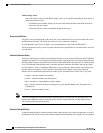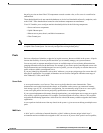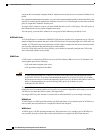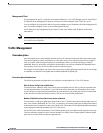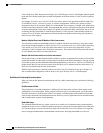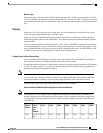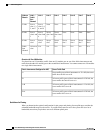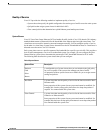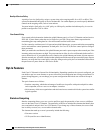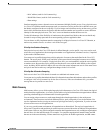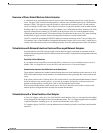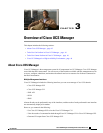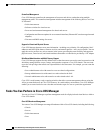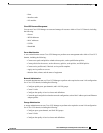
Quality of Service Policy
A quality of service (QoS) policy assigns a system class to the outgoing traffic for a vNIC or vHBA. This
system class determines the quality of service for that traffic. For certain adapters you can also specify additional
controls on the outgoing traffic, such as burst and rate.
You must include a QoS policy in a vNIC policy or vHBA policy and then include that policy in a service
profile to configure the vNIC or vHBA.
Flow Control Policy
Flow control policies determine whether the uplink Ethernet ports in a Cisco UCS domain send and receive
IEEE 802.3x pause frames when the receive buffer for a port fills. These pause frames request that the
transmitting port stop sending data for a few milliseconds until the buffer clears.
For flow control to work between a LAN port and an uplink Ethernet port, you must enable the corresponding
receive and send flow control parameters for both ports. For Cisco UCS, the flow control policies configure
these parameters.
When you enable the send function, the uplink Ethernet port sends a pause request to the network port if the
incoming packet rate becomes too high. The pause remains in effect for a few milliseconds before traffic is
reset to normal levels. If you enable the receive function, the uplink Ethernet port honors all pause requests
from the network port. All traffic is halted on that uplink port until the network port cancels the pause request.
Because you assign the flow control policy to the port, changes to the policy have an immediate effect on how
the port reacts to a pause frame or a full receive buffer.
Opt-In Features
Each Cisco UCS domain is licensed for all functionality. Depending upon how the system is configured, you
can decide to opt in to some features or opt out of them for easier integration into existing environment. If a
process change happens, you can change your system configuration and include one or both of the opt-in
features.
The opt-in features are as follows:
• Stateless computing, which takes advantage of mobile service profiles with pools and policies where
each component, such as a server or an adapter, is stateless.
• Multi-tenancy, which uses organizations and role-based access control to divide the system into smaller
logical segments.
Stateless Computing
Stateless computing allows you to use a service profile to apply the personality of one server to a different
server in the same Cisco UCS domain. The personality of the server includes the elements that identify that
server and make it unique in the Cisco UCS domain. If you change any of these elements, the server could
lose its ability to access, use, or even achieve booted status.
The elements that make up a server's personality include the following:
• Firmware versions
• UUID (used for server identification)
Cisco UCS Manager GUI Configuration Guide, Release 2.0
38 OL-25712-04
Opt-In Features



